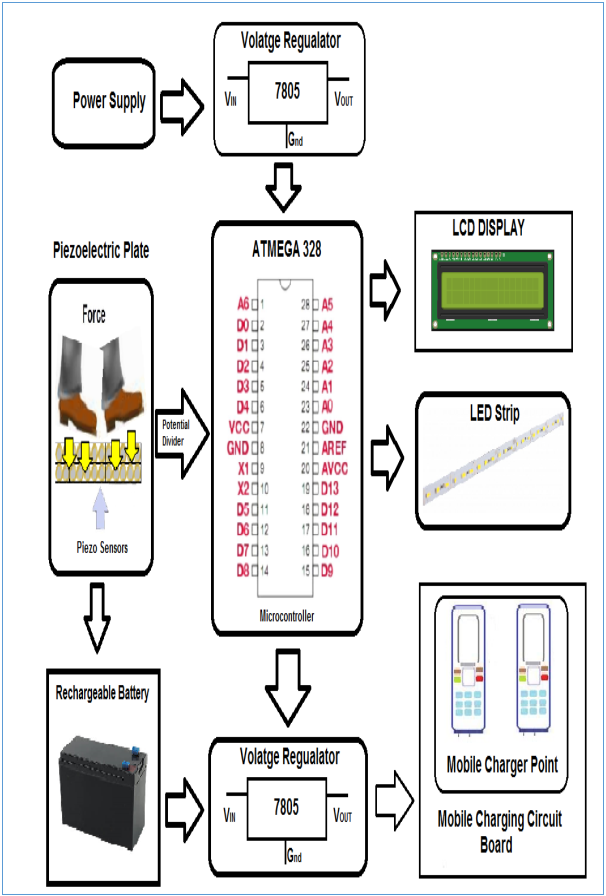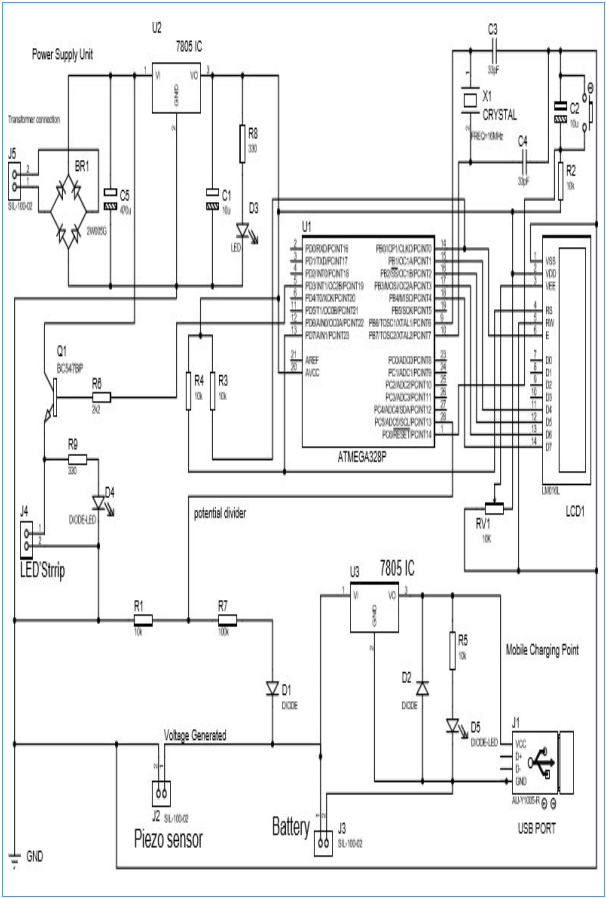Design Specifications for Engineering Project
Introduction
For large development projects, defining the problem becomes the development of design specifications. Typically, development project are complex, involving a number of people from different disciplines working toward the same goal. This chapter discusses the following topic that describe the process and the importance of developing design specification:
- Specifications of a DesignÂÂ
- General Description
- Specification of Material
- Circuit Simulation Specification
- Cost Specification
3.1. Specifications of a DesignÂÂ
Specifications are nothing more than a formal document listing the requirements of a project. The opinion of the project is to energy harvesting through flooring, which is built with piezoelectric technology, the electrical energy created by the weight of human footsteps walking around from place to place, which is caught by floor piezoelectric sensors and get compressed and decompressed, then energy is stored and utilized as a power source. The figure (x) here represent the structure of the energy harvesting design in the form of blocks.

3.2. General Description
The author has tried to evaluate when a full amount of weight is sensed by the piezoelectric sensors mounted on a platform, and the voltages which generated will be stored in the Battery. The Battery which is charged, further connected to the Mobile Charging Circuit board as appliances. Board consists a USB point, where users may connect cables to charge a mobile phone from the battery charged.
The arrangement also consists a 12-volt power supply adapter with voltage regulator, which will provide to the monitoring circuit based on a microcontroller to monitor the output voltage which generated across the sensors using potential divider physics. The level of a voltage generated and whenever human walks through platform the count of the footsteps is to be recorded and displayed on the LCD.
LEDs require DC supply to operate. A string of LEDs is mounted below the platform (floor) when the voltage generated by the weight of human footsteps the LEDs will be blink through the microcontroller circuit.
Consequently, the voltage which generated using energy harvesting device “Piezoelectric Power Generation System” is can be utilized within different appliances; mobile charging, street or corridor lighting, bus or airports station lighting, nightclubs, rural areas, charging technologies for electric vehicles, etc. The more power could be generated using the equivalent technique; researchers are investigating in piezoelectricity for bigger designs.
3.3. Specification of Material
The minimum requirements of materials to build an energy harvesting device is illustrated below;
|
Statement Of Material |
||
|
Component Name |
significance |
Quantity |
|
Resistors [Ω] |
10K |
5 |
|
2.2K |
1 |
|
|
100K |
1 |
|
|
330K |
2 |
|
|
10K POT. |
1 |
|
|
Capacitors |
10 uF/63V |
2 |
|
33 PF |
2 |
|
|
470 uF/35V |
1 |
|
|
Integrated Circuits |
ATMEGA 328 |
1 |
|
7805 |
2 |
|
|
IC Bases |
8-PIN |
1 |
|
Transistor |
BC 547 (NPN) |
1 |
|
Diodes |
IN4007 |
2 |
|
Bridge Diode |
2 |
|
|
Miscellaneous |
Piezoelectric Sensor |
8 |
|
Crystal 16MHz |
1 |
|
|
LCD 16Ã-2 |
1 |
|
|
Burge Strip 16 Pin-male |
1 |
|
|
LED Strip |
1 |
|
|
RED LED |
3 |
|
|
2-Pin Push Button |
1 |
|
|
USB CONNECTOR |
1 |
|
|
PCB CONNECTOR 2-Pin |
1 |
|
|
Weighing Machine Plate |
1 |
|
|
12 Volt Adaptor |
1 |
|
|
USB Wire |
1 |
|
|
Lead Acid Rechargeable Battery 12 Volt |
||
|
Printed Circuit Board |
||
|
Soldering Wire |
||
|
Connecting Wire |
||
3.4. Circuit Simulation Specification
The figure (x), show the schematic diagram for “Piezoelectric Power Generation System Utilizing of Human Footsteps”. The schematic diagram is constructed through circuit simulation software; Proteus Design Suite, which is an Electronic Design Automation tool including schematic capture and PCB layout modules. circuit simulators allow the circuit designer to draw a circuit schematic and simulate circuit operation on a personal computer. Circuit simulators provide a very quick and easy way to evaluate a particular design concept without using expensive test equipment or having to procure parts and assemble a breadboard.

The components short-term justifications of the system are specified below and more in details will found in the further chapter.
Resistor (R)
The circuit diagram of the device has 10 resistors [Ω] and that having different values which 10K, 2.2K, 100K, 330K, and 10K POT. The requirement of this resistor in the circuit is to create specified values of the current and voltage. So, it’s used to oppose an electric current by producing a voltage drop between its terminals in proportion to the current.
Capacitor (C)
The function of the capacitor is to store power in form of an electric field and is called as a ceramic disc with some features like high stability. The circuit of a device has been provided with five capacitors with a value of 10 uF/63V, 33 PF, and 470 uF/35V. And to operate the crystal its specified frequency capacitor is used in circuits.
Transistors
A transistor is a device which is used to make a change in large output with respect to the small input applied to it. In a circuit, 3 terminals BJT (bipolar junction transistor) is used. By the use of the transistor, control large signal at another pair by just applying small input at another pair. Also, it can be used as a switch with the help of small input current as it is a current control device.
IC-Regulator
IC is an integrated circuit used in various applications. In timing device product used 7805 IC as a 5v voltage regulator. Sometimes there is a voltage fluctuation and so it could not get fixed output voltage. So this 7805 IC provides regulated power supply. The main advantage of this IC is to give constant output voltage even there is a variation in input. Also, current limiting protection is provided in IC itself and for other parts of the circuit as well.
Crystal Oscillators
Crystal Oscillator is a device that used in electrical circuits in order to create an electrical signal with an accurate frequency. The need for the frequency of the circuit is to keep the path of the time in quartz and provide a stable signal for the device.
Seven Segments Display
Seven segments display (LCD) is a device that utilized for displaying the status of the circuit. The features of the seven segments display are that it operates in low current. The display will show the status of the device; Level of the voltage generated, and whenever human walks through platform the count of the footsteps is recorded and displayed.
Piezoelectric Sensors
Piezoelectric Sensors also a device, utilize to generate the electrical energy converting different sources. (E.g. Kinetic, Mechanical energy). When a force is applied on a piezo material, a charge is generated. These devices consist an 8 Piezoelectric Sensors which mounted below the platform and convert the human footstep energy into electrical energy.
3.5. Cost Specification
This section is one of the most important section and often that is overlooked. This section determines the potential for the financial success of the project. when considering all the technical details, it’s easy to overlook that the cost of development and the manufacturing cost are crucial to the project success. As such, they must be identified as part of the specification in a compact statement.
After research of components required to harvesting the “Piezoelectric Power Generation System Utilizing of Human Footsteps”, it is expected to fall within the £90 budget. With research the specifications required for the key component excluding postage. Equipment that will be required within the budget includes; Resistor (R), Capacitor (C), Transistors, IC-Regulator, Crystal Oscillators, Seven Segments Display and Piezoelectric Sensors. However, these are all relatively low cost. Facilities required to develop the project including software are available at no costs for the schematic circuit design.
Summary
Having completed the design specification, let us note what has been accomplished and the steps that achieve those accomplishments. The following steps can be used as guideline for completing the design specification in any project;
- Divide the design problem into smaller modules. complete a block diagram.
- Do research on area relating to each design problem. gather more information.
- Develop a cost budget.
- Apply creative thinking!
- Complete a schematic design.
The blank pieces of paper at the beginning of the chapter now have many schematic symbols with their associated circuit traces. The next step involves the selection of the physical components and breadboarding.